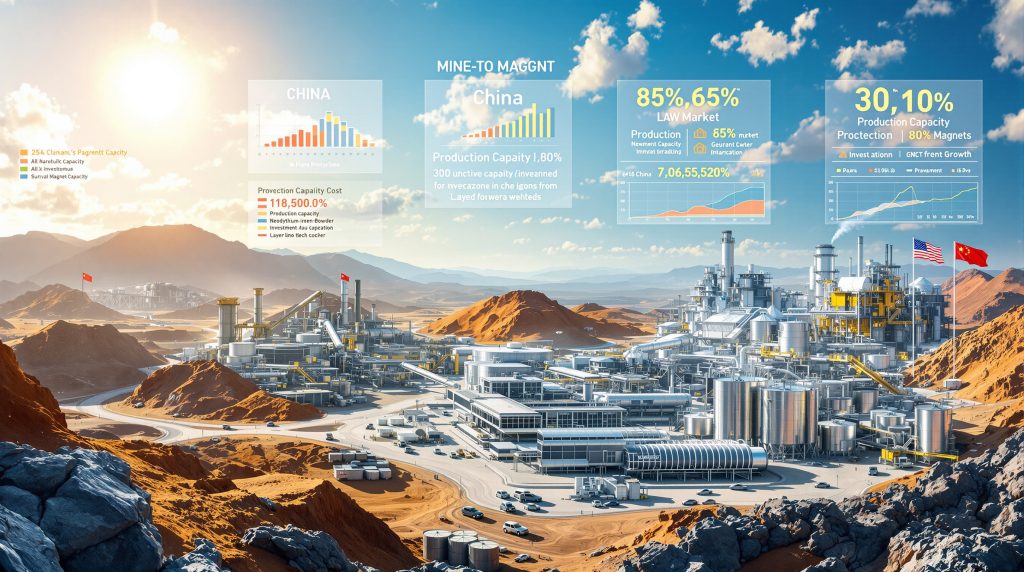The mine-to-magnet supply chain represents a comprehensive industrial ecosystem that transforms raw rare earth minerals into finished permanent magnets essential for modern technology. This integrated process encompasses every stage from initial extraction through final manufacturing, creating a critical foundation for electric vehicles, renewable energy systems, and advanced defence technologies.
Understanding this complete production cycle becomes increasingly important as Western nations recognise their vulnerability to supply disruptions. Recent partnership agreements, such as the collaboration between Pensana and Vacuumschmelze, demonstrate the urgent need to establish domestic capabilities that can support national security requirements and technological advancement.
Understanding the Complete Production Cycle
The mine-to-magnet framework involves multiple distinct phases that require specialised expertise and advanced equipment. Each stage demands precise quality control to produce high-performance neodymium-iron-boron (NdFeB) and samarium-cobalt magnets that power today's technological revolution.
Furthermore, the Pensana-VAC partnership exemplifies this integrated approach, connecting raw material extraction from the Longonjo project in Angola with advanced magnet manufacturing at the eVAC Magnetics facility in South Carolina. Their agreement targets production scaling from 2,000 tonnes per year initially to 12,000 tonnes annually by 2029, demonstrating the substantial capacity expansion required to meet growing demand.
Key production components include clean mixed rare earth carbonate (MREC) as the critical intermediate product that bridges mining operations with final magnet manufacturing. Consequently, this material requires sophisticated processing to achieve the purity levels necessary for defence and commercial applications.
How Does Geopolitical Concentration Create Supply Chain Vulnerabilities?
Current global production remains heavily concentrated in China, creating significant strategic risks for nations dependent on these materials for critical infrastructure, defence systems, and clean energy transitions. However, the Trump critical minerals order and 2027 defence restrictions on rare-earth imports from China have established a hard deadline for developing alternative supply sources.
This concentration creates multiple vulnerabilities that extend beyond simple supply security. For instance, price manipulation, export restrictions, and quality control issues can severely impact industries dependent on high-performance magnets. The semiconductor shortage of recent years provides a stark reminder of how supply chain vulnerabilities can cascade through entire economic sectors.
China's Market Dominance and Strategic Implications
Chinese companies have invested decades building integrated facilities that combine mining operations with downstream processing capabilities. This vertical integration provides cost advantages and operational efficiency that competing nations struggle to match, particularly given the complex chemistry and substantial capital requirements involved in rare earth processing.
Moreover, the technical expertise accumulated over decades of industrial development creates barriers to entry that extend far beyond simple capital investment. Rare earth separation requires sophisticated solvent extraction techniques, precise temperature control, and multiple purification stages that demand specialised knowledge and equipment.
Western Response to Supply Chain Risks
The United States and allied nations have launched comprehensive initiatives to establish domestic mine-to-magnet capabilities. In addition, these efforts involve substantial government investment, private sector partnerships, and strategic procurement programmes designed to reduce foreign dependency.
Government support has proven essential for establishing competitive operations. The Trump Administration and the US International Development Finance Corporation have provided crucial backing for partnerships like the Pensana-VAC collaboration, recognising these materials as critical for national security applications, including establishing a critical minerals reserve.
What Are the Key Technical Challenges in Building Domestic Supply Chains?
Establishing mine-to-magnet operations requires overcoming significant technical and economic barriers that extend far beyond simple mineral extraction. The complex metallurgy involved in rare earth separation and magnet production demands specialised knowledge accumulated over decades of industrial development.
Chemical Processing Complexity
Rare earth elements occur together in mineral deposits and share similar chemical properties, making separation extremely challenging. Consequently, the process requires sophisticated separation techniques that must achieve exceptional purity levels for high-performance applications.
Temperature control, chemical reagent management, and multi-stage purification systems represent just the beginning of technical challenges. Furthermore, each rare earth element requires specific processing parameters, and maintaining consistent quality across different elements demands extensive process control capabilities.
Accelerated Development Timelines
The urgency of establishing domestic supply chains has compressed traditional development timelines. For instance, Pensana's Longonjo mine, originally scheduled for production in early 2027, is being evaluated for acceleration to late 2026 to meet critical defence deadlines.
This acceleration requires careful balance between speed and operational readiness. However, the mine is currently financed and under construction, providing a foundation for timeline compression that many greenfield projects cannot achieve.
Timeline Challenges:
- Mining permit approvals: 3-5 years typically
- Equipment procurement and installation: 2-3 years
- Process optimisation and startup: 1-2 years
- Workforce training and certification: 6-12 months
How Are Companies Establishing Integrated Supply Chains in North America?
Several strategic partnerships have emerged to create vertically integrated mine-to-magnet operations across North America, combining mining expertise with advanced manufacturing capabilities. These collaborations leverage government support programmes while addressing the technical challenges of rare earth processing.
The Pensana-VAC Strategic Alliance
The memorandum of understanding between Pensana and Vacuumschmelze represents a significant advancement in establishing Western supply chain independence. This partnership connects one of the world's largest undeveloped rare earth deposits with global leadership in permanent magnet manufacturing.
Furthermore, this collaboration aligns with broader industry innovation trends that emphasise vertical integration and strategic partnerships.
Partnership Specifications:
| Component | Details |
|---|---|
| Initial Production | 2,000 t/y rare earth magnets |
| Target Capacity (2029) | 12,000 t/y rare earth magnets |
| Contract Duration | Initial 5-year term with extensions |
| Feedstock | Clean mixed rare earth carbonate (MREC) |
| Source Location | Longonjo project, Angola |
| Processing Facility | eVAC Magnetics, Sumter, South Carolina |
The agreement establishes strategic cooperation to strengthen the global rare earth value chain while exploring additional joint opportunities beyond the initial production targets. In addition, this approach creates flexibility for capacity expansion as market demand evolves.
Geographic Supply Diversification
The partnership demonstrates geographic diversification strategies that reduce concentration risk while leveraging comparative advantages. For example, Angola's mineral resources combine with American processing capabilities and German technical expertise to create a resilient supply network.
This geographic distribution provides multiple benefits:
- Resource Security: Access to world-class mineral deposits
- Processing Excellence: Advanced manufacturing capabilities
- Market Access: Direct supply to defence and commercial customers
- Political Stability: Reduced dependency on single-country sources
Expansion Planning and Resource Development
Pensana has committed to major exploration programmes designed to expand resource inventory beyond current reserves. This forward-looking approach targets growing demand from electric vehicles, automation systems, and emerging applications like humanoid robotics.
Consequently, the exploration strategy recognises that current reserves, while substantial, may prove insufficient for long-term demand projections. Electric vehicle adoption alone could require significant capacity expansion beyond currently planned levels.
What Role Does Government Policy Play in Supply Chain Development?
Government support has proven essential for establishing competitive mine-to-magnet operations, given the substantial capital requirements and long development timelines involved. Policy frameworks combine direct investment, purchase guarantees, and regulatory support to encourage private sector participation.
Strategic Investment and Partnership Programmes
The Trump Administration has prioritised domestic rare earth capabilities as a national security imperative, providing both financial support and regulatory facilitation for critical projects. Furthermore, this support extends beyond domestic operations to include trusted international partners like the Pensana-VAC collaboration.
The US International Development Finance Corporation has played a crucial role in enabling partnerships that enhance Western supply chain resilience. For instance, this support includes financing mechanisms that help bridge the gap between private sector capabilities and strategic national requirements, similar to Europe's critical raw materials facility.
Defence Procurement Mandates
The 2027 defence restrictions on rare-earth imports from China create guaranteed demand for domestic production capabilities. These procurement mandates provide revenue certainty that helps justify the substantial capital investments required for mine-to-magnet operations.
However, defence applications typically require higher-grade materials with stricter quality specifications than commercial markets. This creates premium pricing opportunities that can support the economics of domestic production despite higher initial costs compared to Chinese suppliers.
Regulatory Framework Development
Government agencies have worked to streamline permitting processes for critical mineral projects while maintaining environmental and safety standards. Consequently, this regulatory support proves essential for meeting compressed development timelines driven by strategic requirements.
Environmental review processes, mining permits, and facility approvals typically require years of preparation. Furthermore, expedited review processes for strategically important projects help balance national security needs with regulatory compliance requirements.
Which Technologies Drive Modern Magnet Manufacturing Excellence?
Advanced magnet production requires sophisticated technologies that precisely control material properties, dimensional accuracy, and magnetic performance. These manufacturing processes represent decades of accumulated expertise that new market entrants must develop or acquire through partnerships.
Advanced Manufacturing Capabilities
VAC's recently commissioned eVAC Magnetics facility in South Carolina represents state-of-the-art magnet manufacturing technology. The facility demonstrates how advanced equipment and process control systems enable production of high-performance permanent magnets that meet stringent defence and commercial specifications.
Moreover, modern NdFeB magnet production utilises sophisticated metallurgical processes that rapidly cool molten alloys to create optimal microstructures. This technology, combined with precision powder metallurgy techniques, enables production of magnets with exceptional magnetic properties and dimensional accuracy.
Quality Control and Performance Standards
Magnet manufacturing requires comprehensive quality control systems that monitor magnetic properties, dimensional accuracy, and material composition throughout production. These systems ensure consistent performance in demanding applications such as electric vehicle motors and military systems.
Critical Quality Parameters:
- Magnetic flux density consistency
- Coercivity measurements across temperature ranges
- Dimensional tolerances for precision assembly
- Corrosion resistance for harsh environments
- Temperature stability for extreme operating conditions
Process Innovation and Efficiency
Manufacturing excellence extends beyond basic production to include process optimisation, waste minimisation, and energy efficiency improvements. These factors become increasingly important as production scales to meet growing demand while maintaining cost competitiveness.
In addition, advanced automation and process control systems enable consistent production quality while reducing labour requirements and improving safety outcomes. These technological advantages prove essential for competing with established international producers through data-driven operations.
How Do Environmental Considerations Impact Supply Chain Development?
Modern mine-to-magnet operations must address environmental concerns that extend throughout the production cycle, from responsible mining practices to waste management and recycling programmes. These considerations increasingly influence investment decisions and regulatory approval processes.
Sustainable Mining Practices
Contemporary rare earth mining operations implement advanced environmental management systems that minimise water usage, control dust emissions, and prevent groundwater contamination. Furthermore, these practices require additional investment but are essential for obtaining operating permits in developed nations.
The Longonjo project has incorporated environmental considerations into its development planning, recognising that sustainable practices provide long-term operational advantages and community acceptance. However, modern mining techniques can significantly reduce environmental impact compared to historical operations.
Waste Management and Processing Efficiency
Rare earth processing generates various waste streams that require careful management to prevent environmental contamination. Consequently, advanced processing techniques focus on minimising waste generation while maximising material recovery efficiency.
Closed-loop water systems, chemical recovery processes, and waste treatment facilities represent standard components of modern rare earth operations. These systems add to initial capital costs but provide long-term operational benefits and regulatory compliance.
Magnet Recycling and Circular Economy
Permanent magnet recycling represents an emerging opportunity to reduce primary mining requirements while capturing value from end-of-life products. Advanced recycling technologies can recover rare earth elements from used magnets, creating secondary supply sources that complement primary production.
Recycling technologies could potentially supply significant portions of rare earth demand within the next decade, reducing pressure on primary mining operations while improving overall supply chain sustainability.
Recycling programmes require sophisticated collection networks, dismantling procedures, and reprocessing capabilities. Furthermore, as electric vehicle adoption accelerates, the volume of magnets available for recycling will increase substantially, creating new supply chain opportunities.
What Market Applications Drive Mine-to-Magnet Demand Growth?
The rapid expansion of electric vehicles, renewable energy systems, and advanced manufacturing creates unprecedented demand for high-performance permanent magnets. Understanding these market drivers helps explain the urgency behind establishing secure supply chains and the broader mine to magnet supply chain development.
Electric Vehicle Market Expansion
Electric vehicles represent the fastest-growing application for rare earth permanent magnets, with each vehicle requiring multiple kilograms of high-performance magnetic materials. Consequently, traction motors, power steering systems, and auxiliary components all depend on permanent magnet technology.
The automotive industry's transition to electrification creates predictable, long-term demand that supports investment in domestic supply chain capabilities. Major automakers have committed to electric vehicle production targets that require substantial magnet supply increases over the next decade.
Automation and Robotics Applications
Industrial automation systems, precision robotics, and emerging humanoid robot applications create additional demand growth beyond traditional markets. These applications often require specialised magnet configurations with exceptional performance characteristics.
For instance, Pensana's exploration programme specifically targets demand from automation and humanoid robot applications, recognising these emerging markets as significant growth drivers. Advanced manufacturing systems rely heavily on precise servo motors that utilise rare earth magnets for positioning and control applications.
Renewable Energy Infrastructure
Wind turbine generators, particularly offshore installations, utilise permanent magnet technology for improved efficiency and reliability. Large wind turbines require substantial quantities of rare earth magnets, creating concentrated demand from renewable energy projects.
Furthermore, the global transition to renewable energy creates sustained demand growth that aligns with national energy security objectives. Domestic magnet production supports both clean energy goals and strategic material independence, as highlighted by initiatives to establish mine to magnet supply chains in the US.
How Do Companies Manage Supply Chain Risk and Resilience?
Establishing resilient mine-to-magnet supply chains requires comprehensive risk management strategies that address operational, financial, and geopolitical uncertainties. Companies are implementing diverse approaches to ensure supply security while maintaining cost competitiveness.
Strategic Partnership Structures
The Pensana-VAC partnership demonstrates how strategic alliances can distribute risk while combining complementary capabilities. The five-year initial term with extension options provides flexibility to adapt to changing market conditions while ensuring supply continuity.
However, contract structures include pricing mechanisms that balance cost predictability with market responsiveness. These arrangements help manage commodity price volatility while ensuring sustainable economics for both mining and manufacturing operations.
Operational Risk Mitigation
Mine-to-magnet operations face multiple operational risks including equipment failures, process disruptions, and quality control challenges. Consequently, successful operations implement comprehensive risk management systems that address these potential disruptions.
Risk Mitigation Strategies:
- Redundant equipment systems for critical processes
- Multiple supplier relationships for key consumables
- Comprehensive insurance coverage for operational disruptions
- Emergency response procedures for environmental incidents
- Quality control systems with multiple verification points
Financial Risk Management
Long development timelines and substantial capital requirements create significant financial risks that require careful management. Furthermore, government support programmes help bridge financing gaps while private investment provides operational flexibility.
The Longonjo mine's financed status demonstrates successful risk management that enables project advancement despite challenging market conditions. This financial foundation provides stability for the broader partnership with VAC.
What Does the Future Hold for Mine-to-Magnet Supply Chains?
The next decade will likely see significant expansion of Western mine-to-magnet capabilities as government support programmes mature and private investment accelerates. However, achieving supply chain independence will require sustained commitment and continued technological advancement.
Production Capacity Scaling
The Pensana-VAC partnership's scaling from 2,000 to 12,000 tonnes annually by 2029 represents substantial capacity growth that could significantly impact Western supply security. This expansion requires successful execution of mining, processing, and manufacturing components simultaneously.
Furthermore, additional partnerships and projects will likely emerge as market demand grows and government support programmes expand. The success of early initiatives like Pensana-VAC will influence future investment decisions and policy support.
Technology Innovation Opportunities
Ongoing research focuses on developing alternative magnet technologies that maintain performance characteristics while reducing rare earth content requirements. These innovations could potentially reshape supply chain requirements and reduce strategic material dependencies.
In addition, advanced recycling technologies, improved processing efficiency, and alternative material development represent key innovation areas that could enhance supply chain resilience. Investment in research and development proves essential for long-term competitiveness.
Market Demand Evolution
Future demand growth will likely exceed current projections as new applications emerge and existing markets expand. Humanoid robotics, advanced aerospace systems, and next-generation electric vehicles may require magnet capabilities that current projections underestimate.
Consequently, the strategic importance of rare earth magnets will likely increase as technology dependence grows across multiple sectors. Defence applications, clean energy systems, and advanced manufacturing all require continued access to high-performance magnetic materials.
Investment and Partnership Expansion
Successful partnerships like Pensana-VAC will likely catalyse additional investment and collaboration across the mine-to-magnet supply chain. Government support programmes provide frameworks for future partnerships that can build upon proven models.
Furthermore, international collaboration between trusted partners offers advantages over purely domestic approaches, combining resource access with technical expertise and market reach. These partnerships can achieve supply security while maintaining economic efficiency.
The mine-to-magnet supply chain represents one of the most critical industrial challenges of the 21st century, combining complex technical requirements with significant geopolitical implications. Success in establishing resilient domestic capabilities will determine technological competitiveness and national security for decades to come.
As partnerships like Pensana-VAC demonstrate early success, the foundation exists for broader supply chain transformation that can meet growing demand while ensuring strategic independence. However, the next few years will prove crucial for establishing the production capabilities required to support America's technological and defence requirements.
Ready to capitalise on the next breakthrough in critical minerals supply chains?
Discovery Alert's proprietary Discovery IQ model delivers real-time alerts on significant ASX mineral discoveries, instantly empowering subscribers to identify actionable opportunities ahead of the broader market. Understand why major mineral discoveries can lead to substantial market returns by exploring Discovery Alert's dedicated discoveries page, showcasing historic examples of exceptional outcomes, and begin your 30-day free trial today to position yourself ahead of the market.




